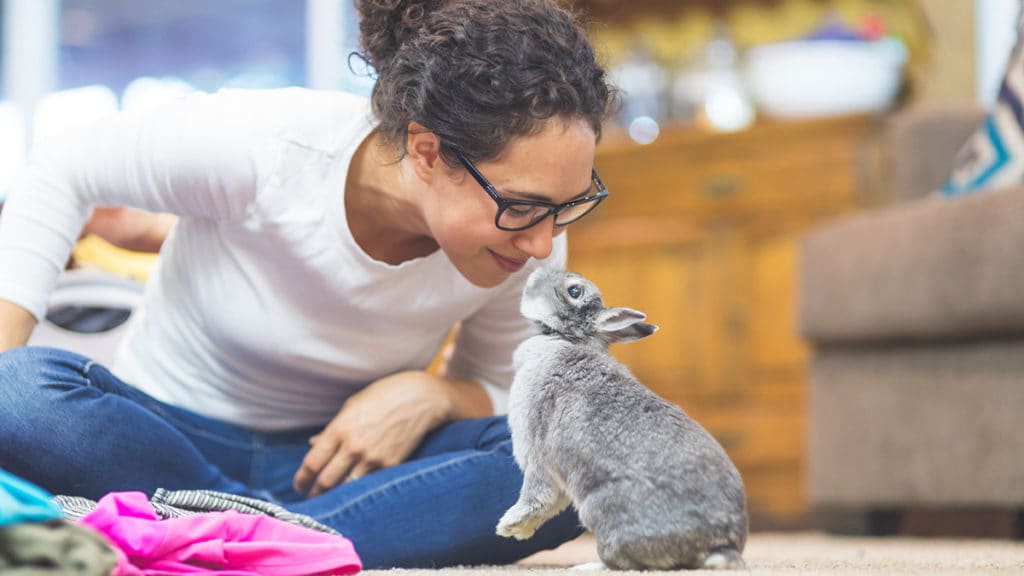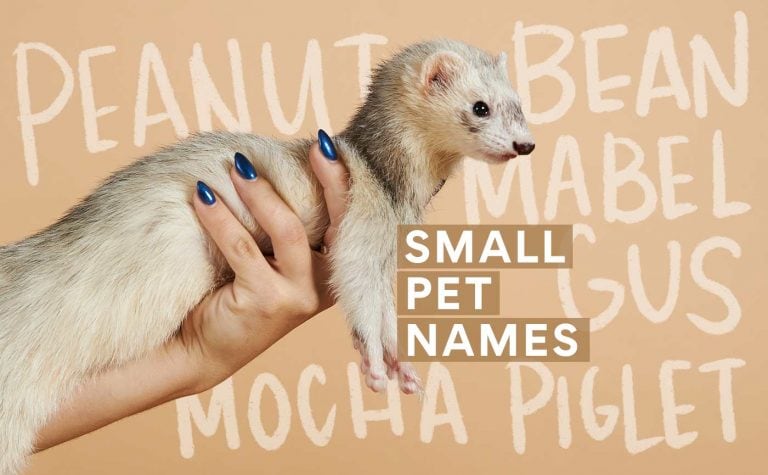Thinking about rabbit adoption? Rabbits can make wonderful pets—but before you adopt a bunny rabbit, it’s important to know how to care for them.
“Rabbits have a lot of personality,” says Barbara B. Tomaras, DVM, owner of Exoticare Veterinary Services in Miami, Florida. “You can find cuddly rabbits, and rabbits that are fun and entertaining. They’re very easy to keep.”
They also are “not an expensive pet,” Dr. Tomaras says. Compared to the annual expenses for dogs and cats, which are upwards of $1,000 dollars, caring for a bunny averages around $500 a year, not including rabbit adoption fees.
Read on to discover important information about rabbit care and the rabbit supplies you need before adopting a rabbit.
Top Rabbit Types
Like dogs and cats, rabbits come in different breeds or types. According to Dr. Tomaras, miniature rabbits, lop-eared rabbits and giant breeds are most popular amongst people looking to adopt a bunny rabbit.
The giant breeds, such as the Flemish Giant, tend to be calmer, she says. The miniatures, like the Dwarf Hotot, often are energetic and nervous, and the lop-eared, such as the Holland Lop, can be cuddly and friendly, she adds.
Although "pet store rabbits are likely 50 percent mix” breeds, people still seek out specific bunny breeds for a particular look or disposition, Dr. Tomaras says. For example, the luxurious locks of the long-haired Angora breeds are attractive to some, including knitters, but a grooming nightmare to others.
The adorably-maned Lionhead rabbits show off a lion-like ruff of fur around their heads and a sparkling personality. Laid-back Dutch rabbits are another popular choice for bunny adoption, as are the playful Rex rabbits.
After researching and deciding which rabbit breed is right for you, make sure you are well prepared with the rabbit supplies below.
Where to Adopt a Rabbit
You might be tempted to head to the pet store to buy a rabbit, but Dr. Sandra Mitchell, DVM, DAVBP, suggests potential adopters start their bunny search at a local rabbit shelter. “There are rabbit shelters in pretty much all states,” she says, adding that the House Rabbit Society, a nonprofit rabbit rescue organization, keeps an updated list of rabbit shelters and rescues across the U.S.
“Regular dog and cat shelters will also often have bunnies from homes,” Dr. Mitchell says. “My last resort would be considering adopting or rescuing (aka purchasing) rabbits from pet stores or breeders.” (You can find out more about why many pet stores are problematic here.)
“A determined owner can certainly find a really nice bunny in need of a home through a shelter,” she says, “and the rabbit will repay the person with a lifetime of love!”
Rabbit Supplies
To keep your rabbit healthy and happy, you need the proper rabbit supplies on hand. These basics are best to have on hand when preparing to adopt a bunny rabbit.
A Well-Balanced Rabbit Diet
The first thing to consider about rabbit adoption is your new pet’s diet. Hay is essential for healthy rabbits, Dr. Tomaras says. Not supplying enough is the number one mistake she sees pet parents make.
“This is what rabbits should be eating the most of,” she says. “It’s fundamental.”
Dr. Tomaras recommends alfalfa hay for rabbits under 7 months old. After that age, they can eat timothy hay.
Hay provides fiber for digestion and helps wear down their teeth, which grow continuously in rabbits. Hay can be hung from a “hay feeder,” like the Ware Small Animal Hay Feeder, and placed in the litter box.
Along with hay, rabbits eat a pellet diet. According to Dr. Tomaras, the ideal feed is a uniform color and type. An example is Oxbow Essentials Adult Rabbit Feed, which is made of timothy grass meal. If a rabbit’s base diet is mixed with seeds or colored treats, they might pick out their favorites to eat, resulting in poor nutrition.
Offer adult rabbits two handfuls of fresh vegetables a day, including leafy greens, carrot tops, and beet greens, and the occasional small piece of fruit as a treat. Introduce each new rabbit food slowly, one at a time, to watch for any negative reaction, such as diarrhea, Dr. Tomaras says. Check out this list of fruits and vegetables generally considered safe for rabbits.
Make sure to provide a solid ceramic bowl for water, because rabbits “don’t drink well” out of the bottle feeders, Dr. Tomaras says. The Living World Ergonomic Small Pet Dish is a bacteria-safe ceramic bowl that can help quench your rabbit’s thirst.
Rabbit Housing
A secure home will help your rabbit feel comfortable and safe. Dr. Tomaras favors a playpen setup with room for your rabbit to exercise, but a two-level cage will offer a rabbit more room as well, compared to a single-level cage. Too small of a space will stress out your rabbit.
Choose a unit with a wire-free bottom. Resting on a wire grate will hurt your rabbit’s haunches, so opt for a solid bottom.
Because bunnies are prey animals, your pet needs a place to hide within their living space. Include a cage or small hutch to give your bunny a little extra privacy.
Note: If you let your rabbit outside of their cage or playpen, always supervise them. Rabbits are ferocious chewers and sometimes chew baseboards, carpet, plants and furniture, which can result in costly vet visits or even death if they nibble on old lead paint, poisonous houseplants or ingest items. Also keep all wires and cables fully out of their reach to avoid electrocution, Dr. Tomaras cautions.
Rabbit Bedding and Litter
For bedding, wood shavings are not recommended because they can pose a health risk from the dust or if your rabbit ingests it, Dr. Tomaras says. Instead, try an option like Kaytee Clean & Cozy Bedding, which is designed to be eco-friendly and dust-free.
Regular cat litter is unsafe for rabbits. However, Dr. Tomaras does recommend Yesterday’s News Cat Litter as the exception because it’s made from recycled paper. Always opt for paper or compressed-pine bedding and litter.
Rabbit Toys
After you adopt a bunny rabbit, add toys to their environment to provide enrichment and keep them engaged. Some of the best rabbit toys involve hay or straw as an enticement, Dr. Tomaras says.
Toys that satisfy a rabbit's need to chew are always a hit. Try willow bark balls or rabbit toys designed for playing and tossing.
An empty cardboard box or paper bag stuffed with safe chew items can entice your bunny to play, as can tunnels or small climbing areas. These pets enjoy grass mats or jute mats, too. Just be sure your pet is not ingesting their toys or other non-edible playthings, Dr. Tomaras cautions.
Grooming Your Rabbit
Rabbits have two major sheds a year, but they will “groom themselves for hours every day,” Dr. Tomaras says. Because they can be sensitive about brushing, she suggests using Mr. Peanut's Hand Gloves Grooming & Deshedding Aid that slips right on your hand.
Rabbits need their nails trimmed regularly. If you are uncomfortable taking care of your pet’s nails, you can have your vet do it.
Here’s a perk of bunny adoption: There’s typically no need to bathe a rabbit. “Rabbits are very clean animals,” Dr. Tomaras says.
Veterinary Care
If you’re feeding your rabbit a healthy diet and have provided them with spacious housing, they won’t need much veterinary care, Dr. Tomaras says. There are no expensive vaccines or dewormers needed, so an annual or twice annual checkup, depending on your animal’s health and age, is enough.
However, Dr. Tomaras says that nearly 80 percent of female rabbits are likely to develop uterine cancer by 5 years old, so after you adopt a bunny, she recommends having your new pet spayed. Male rabbits can be neutered if they exhibit bad behaviors, such as marking or aggression.
Preparing Your Home for Rabbit Adoption
Rabbits can live 12-13 years, so choosing to adopt a bunny rabbit is a long-term commitment. Be sure to educate family members on proper rabbit care. Children especially must be taught how to handle these delicate animals. Rabbits have sensitive backs, Dr. Tomaras says.
“If they fall and break their back, they can be paralyzed very easily,” she adds.
A rambunctious puppy or child can stress your rabbit out. Cats and rabbits typically get along OK, but few dogs and bunnies do because of canines’ instincts to chase, Dr. Tomara adds.
Rabbits often are happier if kept in pairs, Dr. Tomaras says. Paired rabbits tend to experience less stress and even live longer, she adds.
So how do you know if your rabbit is happy? A content rabbit might reward pet parents with a binky (a leap of happiness) or stretch out on their side in satisfaction to sleep. Read “12 Common Rabbit Behaviors That Might Puzzle You” to learn more about binkies and other rabbit behaviors.
“Rabbits are an independent pet, but they also love interaction with humans,” Dr. Tomaras says. “And they have the advantage of not requiring an enormous maintenance … it’s a pleasant and easy pet to have.”
Share:














